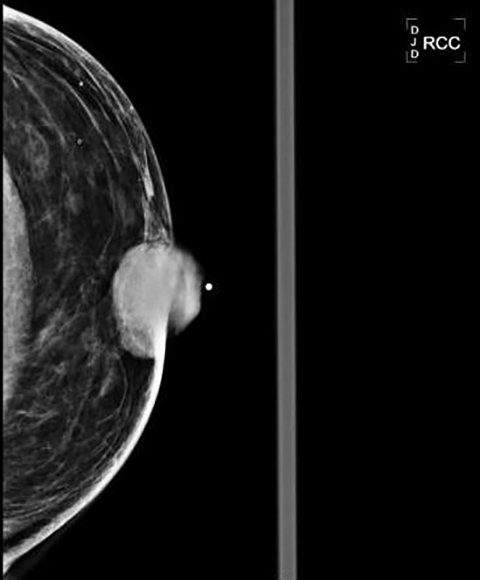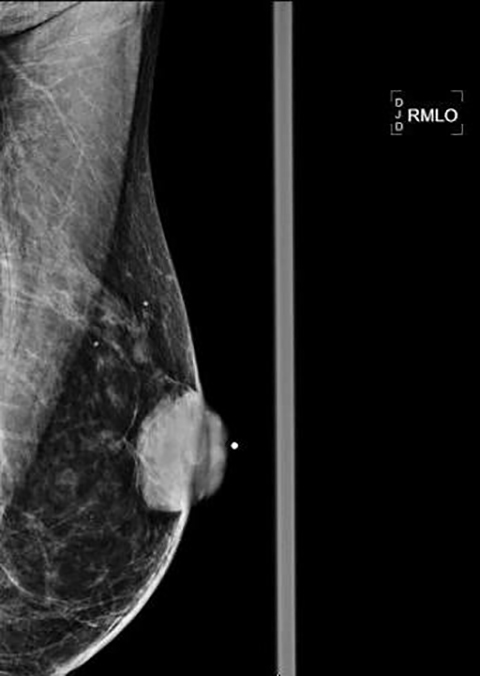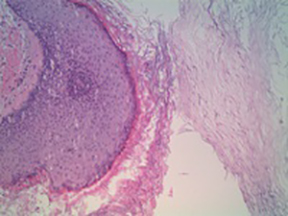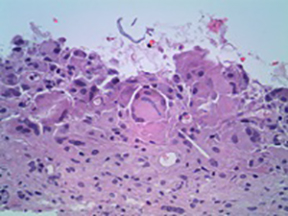Rare case of benign epidermal inclusion cyst mimicking malignancy
Images





CASE SUMMARY
This case presents a 42-year-old female complaining of right nipple swelling, palpable mass, and non-bloody nipple discharge. The patient reported a history of bilateral breast reduction and no family history of breast cancer. The subareolar location of the patient’s swelling and mass complicated diagnosis by limiting physical exam. Diagnostic mammogram revealed a 3.8 cm mass with macrolobulated and partially obscured borders. Ultrasound demonstrated a solid ovoid mass. Radiologic imaging of this breast lesion could not exclude malignancy, resulting in BI-RADS 4a classification. Given the suspicious features of this lesion and the clinical context, subsequent fine needle aspiration was performed and showed squamous epithelium with abundant basket weave keratin.
IMAGING FINDINGS
A diagnostic digital mammogram revealed scattered bilateral fibroglandular tissue, benign appearing bilateral calcifications, and a large mass in the immediate subareolar right breast measuring 3.8 × 2.1 cm (Figure 1). The mass displayed macrolobulated borders and the medial border was partly obscured by parenchyma. Ultrasound showed a solid well circumscribed ovoid mass in the immediate subareolar right breast measuring 3.5 × 1.5cm (Figure 2).
DIAGNOSIS
Ruptured epidermal inclusion cyst of the breast, which resulted in local inflammatory changes including nipple swelling and nonbloody nipple discharge. Based on the mammogram and ultrasound appearance of a 3.8 cm circumscribed solid oval subareolar breast mass, both phyllodes tumor and fibroadenoma of the breast could not be excluded.
DISCUSSION
An epidermal inclusion cyst is the most common cutaneous or subcutaneous cyst, and it is lined by stratified squamous epithelium that contains a granular layer and lamellated keratin.1,2 They frequently occur on the face, scalp, neck and trunk; however, very few are found in the breasts.1-5 An epidermal cyst rarely calcifies, but when it does, it is usually in older cysts within the keratin debris.2,3,6
Epidermal inclusion cysts can be caused by congenital factors, squamous metaplasia of columnar epithelium, obstructed hair follicle or pore causing inflammatory downward growth of the epidermis, or trauma related to reduction mammoplasty or needle biopsy that causes epidermal fragments to be implanted more deeply in the breast tissue.2,4,5,7,9,14
Diagnosis of a small epidermal cyst that occurs in the subcutaneous tissue is usually straightforward, but enlarged cysts presenting in the breast parenchyma require them to be differentiated from other benign or malignant breast lesions. There is variable data on the risk of transformation to malignant squamous cell carcinoma (0.045-19 percent) and possible association with Paget’s disease of the breast.11,12,13 While malignant transformation is possible, the pathogenesis of differentiation of an epidermal cyst into carcinoma is not clear. It has been theorized that chronic irritation or repetitive trauma to the epithelial lining of the cyst plays a role in malignant transformation; however, this relationship has not been definitively established.2,3,6,15,16,18
Epidermal inclusion cysts are benign, but can rupture and lead to serious sequelae, further complicating what might otherwise be a straightforward diagnosis. Rupture releases nonabsorbable keratin, irritating the surrounding tissue, which can lead to secondary foreign body reactions, granulomatous reactions, or abscess formation.1,7,16 Five cases of spontaneous rupture have been reported in the literature.7,9 In such atypical or complex cases, fine needle aspiration or surgical excision is usually required for definitive diagnosis and to exclude malignancy.
On mammography, epidermal inclusion cyst of the breast appears as a well circumscribed, usually non-calcified lesion, although older cysts can develop calcification. Ultrasonography demonstrates a solid circumscribed, complex mass.2,4,6,10 Alternating concentric hyperechoic and hypoechoic rings correspond to the layers of lamellated keratin, which classically have been described as an onion ring pattern.11 Aspiration of an epidermal inclusion cyst typically shows cheesy, flaky material, differentiating it from a sebaceous cyst.8
Here we presented a case of epidermal inclusion cyst of the breast in a patient post bilateral reduction mammoplasty who complained of non-bloody nipple discharge, found to be secondary to ruptured epidermal inclusion cyst. Radiologic findings were suspicious for malignancy, and differential diagnosis included both phyllodes tumor and fibroadenoma. Given a BI-RADS 4a classification, subsequent ultrasound-guided biopsy was performed and showed squamous epithelium with abundant basket weave keratin and giant cells (Figure 3), suggesting an epidermal inclusion cyst.
Given the subareolar location and cyst rupture, physical exam proves unreliable for evaluation.1,16 The flexible fat and mammary gland tissue of the breast allows the epidermal inclusion cyst to grow deeper into subcutaneous tissue, making it more difficult to exclude malignancy.3 Other lesions can present in a similar manner, including fibroadenoma, phylloides tumor, fibrocystic disease with squamous metaplasia and metaplastic carcinoma.
CONCLUSION
An epidermal inclusion cyst of the breast is an uncommon benign mass but may lead to serious complications. A patient may present with a palpable mass, pain, or non-bloody nipple discharge following spontaneous rupture in complicated cases. Association with Paget’s disease and possibility for malignant transformation are rare, but documented in the literature. Ultrasound imaging of the breast typically shows an onion ring pattern or heterogeneous hyperechoic and thus solid echo texture if the cyst has ruptured, and mammography may demonstrate a mass with or without calcifications, making it difficult radiologically to exclude a malignant lesion. Although a benign lesion, epidermal inclusion cysts can develop complications and demonstrate suspicious features; in such appropriate circumstances, biopsy may be warranted for definitive diagnosis.
REFERENCES
- Yuan WH, Hsu HC, Lai YC, Chou YH, Li AF. Differences in sonographic features of ruptured and unruptured epidermal cysts. J Ultrasound Med. 2012;31:265-272.
- Kim HS, Cha ES, Kim HH, Yoo JY. Spectrum of sonographic findings in superficial breast masses. J Ultrasound Med. 2005;24:663-680.
- Motabar AR. Epidermal inclusion cysts of the breast. Med J Islam Repub Iran. 2009;22(4):207-211.
- Lee Y, Park S. Giant sized epidermal inclusion cyst of the breast initially mimicking a large fibroadenoma or phyllodes tumor. J Korean Surg Soc. 2012;83:107-110.
- Davies JD, Nonni A, D’Costa HF. Mammary epidermoid inclusion cysts after wide-core needle biopsies. Histopathology. 1997;31:549-551.
- Kwack JY, Park HL, Kim JY, Kim EK, Chung SY, Kwon TH, Hong HS, Oh KK. Imaging finding in a case of epidermal inclusion cyst arising within the breast parenchyma. J Clin Ultrasound. 2004;32(3)141-143.
- Bergmann-Koester CU, Kolberg HC, Rudolf I, Krueger S, Gellisen J, Stoeckelhuber BM. Epidermal cyst of the breast mimicking malignancy: Clinical, radiological and histological correlation. Arch Gynecol Obstet. 2006;273(5):312-314.
- Chantra PK, Tnag JT, Stanley TM, Bassett LW. Circumscribed fibrocystic mastopathy with formation of an epidermal cyst. AJR Am J Roentgeny. 1994;163:831-832.
- Morris PC, Cawson JN, Balasubramaniam. Epidermal cyst of the breast: Detection in a screening programme. Australas Radio. 1991;43:12-15.
- Crystal P, Shaco-Levy R. Concentric rings within a breast mass on sonography: Lamellated keratin in an epidermal inclusion cyst. AJR Am J Roentgenol. 2005;184:S47-S48.
- Cameron DS, Hilsinger RL. Squamous cell carcinoma in an epidermal inclusion cyst: Case report. Otolaryngol Head Neck Surg. 2003, 29: 141-143.
- Menville JG: Simple dermoid cysts of the breast. Ann Surg. 1936;103:49-56.
- Willis RA. Squamous-cell mammary carcinoma of predominantly fibrosarcoma-like structure. J Pathol Bacteriol. 1958;76:511-515.
- Taira N, Aogi K, Ohsumi S, Takashima S, Kawamura S, Nishimura R. Epidermal inclusion cyst of the breast. Breast Cancer. 2007;14(4):434-437.
- Debnath D, Taribagil S, Al-Janabi KJ, Inwang R. A large epidermoid cyst of breast mimicking carcinoma: A case report and review of literature. Int J Surg Case Rep. 2012;3(9):437-440.
- Whang IY, Lee JH, Kim JS, Kim KT, Shin OR. Ruptured epidermal inclusion cysts in the subareolar area: Sonographic findings in two cases. Korean J Radiol. 2007;8(4)356359.
- Singh M, Maheshwari B, Khurana N, Jain S. Epidermal inclusion cyst in breast: Is it so rare? J Cytol. 2012;29(3):169-172.
- Taira N, Aogi K, Ohsumi S, Takashima S, Kawamura S, and Nishimura R. Epidermal inclusion cyst of the breast. Breast Cancer. 2007;14(4)434-437.
Citation
C M, T B, M C, E P, ML Y, H E.Rare case of benign epidermal inclusion cyst mimicking malignancy. Appl Radiol. 2016; (2):34-36.
February 3, 2016